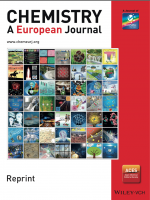Citation:
Mamais M, Degli Esposti} A, Kouloumoundra V, Gustavsson T, Monti F, Venturini A, Chrysina ED, Markovitsi D, Gimisis T. A New Potent Inhibitor of Glycogen Phosphorylase Reveals the Basicity of the Catalytic Site. Chem. - A Eur. J. [Internet]. 2017;23:8800–8805.

Abstract:
© 2017 Wiley-VCH Verlag GmbH & Co. KGaA, Weinheim The design and synthesis of a glucose-based acridone derivative (GLAC), a potent inhibitor of glycogen phosphorylase (GP) are described. GLAC is the first inhibitor of glycogen phosphorylase, the electronic absorption properties of which are clearly distinguishable from those of the enzyme. This allows probing subtle interactions in the catalytic site. The GLAC absorption spectra, associated with X-ray crystallography and quantum chemistry cal culations, reveal that part of the catalytic site of GP behaves as a highly basic environment in which GLAC exists as a bis-anion. This is explained by water-bridged hydrogen-bonding interactions with specific catalytic site residues.Citation Wizard: (Total#-Nonself#-Noncoauthor#-NonGray#)
1-1-1-0 Citation: Åkerbladh, L. Palladium(0)-Catalysed Carbonylative Multicomponent Reactions : Synthesis of Heterocycles and the Application of Quinolinyl Pyrimidines as Enzyme Inhibitors (PhD Dissertation), Uppsala University, 2017.
2-2-1-1 Citation: M. S. Chegkazi, M. Mamais, A. I. Sotiropoulou and E. D. Chrysina, in Rational Drug Design, eds. T. Mavromoustakos and T. F. Kellici, Springer New York, New York, NY, 2018, pp. 89–111.
3-2-1-1 Citation: A. Stathi, M. Mamais, E. D. Chrysina and T. Gimisis, Molecules, 2019, 24, 2327.
4-2-1-1 Citation: V. Maffeis, K. Mavreas, F. Monti, M. Mamais, T. Gustavsson, E. D. Chrysina, D. Markovitsi, T. Gimisis and A. Venturini, Phys. Chem. Chem. Phys., 2019, 21, 7685–7696.
5-3-2-2: L. Somsák, É. Bokor, L. Juhász, S. Kun, L. Lázár, É. Juhász-Tóth and M. Tóth, Pure Appl. Chem., , DOI:10.1515/pac-2019-0208.
6-4-3-3: A. Pałasz, D. Cież, B. Trzewik, K. Miszczak, G. Tynor and B. Bazan, Top. Curr. Chem., 2019, 377, 19.

